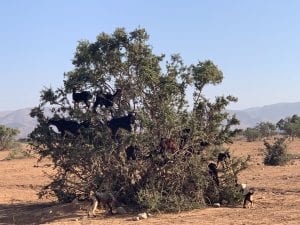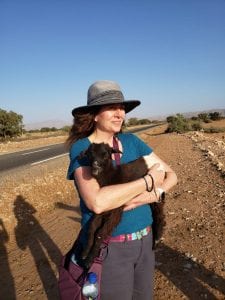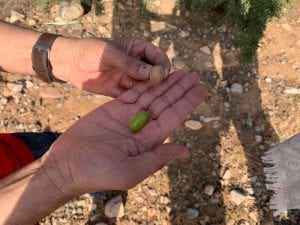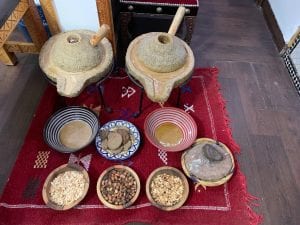The plants, Argan oil cultivation and a visit to the Women’s Argan Cooperative
As we drove towards Tiout, a small southern Moroccan village at the base of the Anti-Atlas Mountains, we saw an amazing site- Trees with goats in them!


These argan trees are special because they are endemic to Southern Morocco and because they are the source of argan oil used for dipping bread, drizzling over cous cous, or as a moisturizing cosmetic product for hair and skin (Do you have some at home now? If so, it is a product of Morocco.)
The delight at seeing these adorable goats in the trees caused me to take dozens of pictures after asking permission of the Amazeer Shepherd (the Amazeer people are native Moroccans) I gave 100 dirhams to the shepherd in appreciation and as we were about to get into the car again, the shepherd returned with a goat in hand offering us the chance to hold him! Our host teacher translated the Tamazight language (language of the Amazeer people) for us and the shepherd said I could name the goat! As I looked across the beautiful countryside, I noted the hazy Anti-Atlas mountain backdrop- the name was determined. Our little goat’s name would be Atlas. I experienced pure joy as I held this feather light goat in hand. After the shepherd saw how I was holding Atlas, he became my teacher and demonstrated the proper way:) Which picture do you think shows the proper way to hold a goat?


So, why would goats climb these trees? This is a great example of how humans can use other living organisms to partially process a resource for use. The goats eat the argan nuts that have a fleshy coating. They then eliminate the pits in their fecal matter! Farmers gather the pits and deliver them to the women’s cooperative for further processing about a mile away. Pretty cool huh?
Close up pictures of an argan nut.

Argan nut processing is a natural, physical process unlike most of our US food products with long unknown chemical lists on our packaging. Mechanization of the processing has not been successful yet.
The women’s cooperative provides economic benefit to local women who are critically important for the argan industry by obtaining the oil rich kernels. When we entered the room, I saw about 20 women sitting on floor cushions cracking open the nuts with rocks. The exterior shell is used for animal feed and the internal white kernel is pressed to release the oil. If the nuts are roasted the oil product takes on a nutty flavor and aroma and is used for culinary oil.
The phrase “ a tough nut to crack” certainly came to mind as I tried many times to crack open a nut. The Amazeer women had lighting speed!



For more information about Argan, an Environmental Concern:
Source-CNN: Argan oil: Morocco’s ‘desert gold’ and the fight for its survival https://www.cnn.com/2016/11/15/africa/argan-oil-morocco/index.html

12 Comments
Leave a reply →